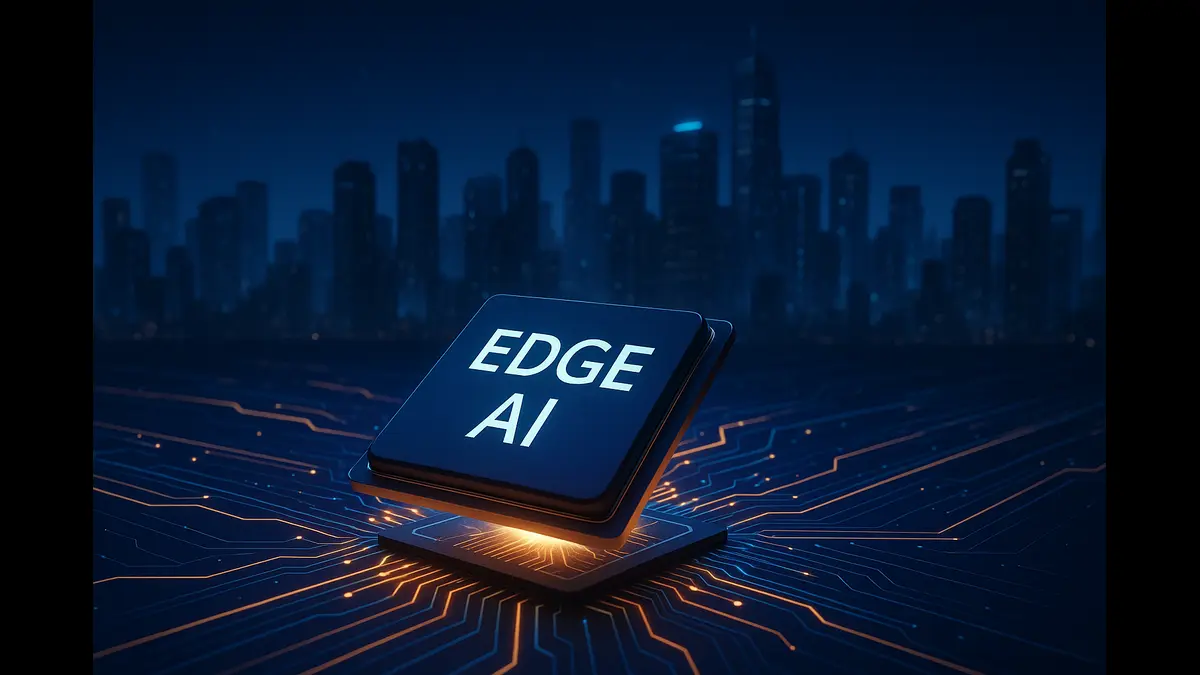
Arm has expanded its Flexible Access program to include the new Armv9 edge AI platform, giving startups and innovators low-cost access to advanced chip designs. This move marks a major step toward democratizing edge intelligence, enabling real-time, secure AI processing directly on devices—from cameras to robots—without relying on the cloud.
In an era where artificial intelligence is reshaping industries, the edge—those everyday devices that surround us—stands poised to become the new frontier of intelligent computing. Arm, a global leader in processor technology, has just made a pivotal move to democratize this future. The company has announced the expansion of its Arm Flexible Access program to include the groundbreaking Armv9 edge AI platform. This initiative lowers the barriers for startups and innovators, offering low-cost or even no-cost entry to cutting-edge tools that could transform how we interact with smart devices.
Picture this: a compact security camera not only capturing footage but analyzing it in real-time to detect anomalies, all without phoning home to a distant server. Or a home assistant that anticipates your needs based on subtle patterns in your routine, processing everything locally to safeguard your privacy. These aren’t distant dreams; they’re the tangible outcomes of Arm’s latest push. By integrating the Armv9 platform into Flexible Access, Arm is empowering a new generation of builders to experiment freely, iterate rapidly, and bring secure, efficient AI to the devices that power our connected world. This isn’t just about technology—it’s about fostering human-centered innovation that enhances daily life while addressing pressing concerns like data security and energy efficiency.
At its core, this announcement underscores Arm’s commitment to accessibility. For years, developing advanced chip designs required significant upfront investment, often sidelining smaller players. Now, with Armv9 in the mix, the playing field levels out, inviting a broader ecosystem to contribute to the AI revolution.
Demystifying Arm Flexible Access: A Gateway for Innovators
Arm Flexible Access isn’t a new concept—it’s a proven model that’s already sparked waves of creativity. Launched to streamline the design process for chip creators, it functions like a comprehensive toolkit on loan. Participants gain immediate, upfront access to Arm’s vast library of intellectual property (IP), development tools, software resources, and expert support. For qualifying startups, this access comes at no initial cost, while established firms benefit from low fees. The beauty lies in its pay-as-you-go structure: designers only commit to full licensing fees once they’ve selected components for production-ready “tape-outs”—the final step in chip fabrication.
This “try before you buy” philosophy removes financial hurdles that once stifled experimentation. Startups can prototype multiple configurations, test AI workloads under real-world constraints, and refine their architectures without the risk of sunk costs. It’s particularly vital in the fast-evolving edge AI space, where power efficiency, performance, and integration must align perfectly from the outset. As Arm notes, this approach provides “the smoothest market entry, lowest cost, and fastest innovation path” for crafting intelligent edge devices.
Consider the human element: for a fledgling team in a garage-turned-lab, the pressure to nail a design on the first try can be paralyzing. Flexible Access eases that burden, allowing focus on creativity rather than capital. It’s a business-savvy move too—by broadening participation, Arm cultivates a richer partner network, accelerating collective progress in IoT and embedded systems.
A Track Record of Transformation: 400 Tape-Outs and Counting
The proof of Flexible Access’s impact is in the numbers—and the names behind them. Over the past five years, the program has facilitated more than 400 successful tape-outs, with over 300 active members harnessing its resources. Remarkably, over half of these designs target embedded and IoT applications, injecting fresh intelligence into everything from wearables to industrial sensors.
Among the standouts are household names that have leveraged Arm’s ecosystem to push boundaries. Raspberry Pi, the beloved single-board computer maker, has long partnered with Arm to drive efficiency and flexibility in its hardware. This collaboration has enabled Raspberry Pi to evolve from hobbyist tools to robust platforms for AI experimentation, ensuring users benefit from continuous improvements in power management and performance. Similarly, Hailo, a pioneer in edge AI processors, has integrated Arm technology into its Hailo-8 accelerator, which delivers up to 26 tera-operations per second (TOPS) for deep learning on resource-constrained devices. This has empowered Hailo to create compact, high-performance chips ideal for automotive vision systems and smart retail solutions.
Then there’s SiMa.ai, whose MLSoC (machine learning system-on-chip) platforms scale physical AI applications like robotics and surveillance. By building on Arm’s flexible compute foundation, SiMa.ai has showcased innovations such as the Modalix system, which processes complex models with minimal latency. Weeteq rounds out the list, contributing to efficient edge processing in consumer electronics. These success stories illustrate how Flexible Access acts as a catalyst, turning bold ideas into market-ready products that touch millions of lives.
The Heart of Armv9: Powering Edge AI with Precision Engineering
At the epicenter of this expansion is the Armv9 edge AI platform, unveiled earlier in 2025 as the world’s first of its kind optimized for IoT workloads. This isn’t a monolithic chip but a synergistic duo: the Arm Cortex-A320 CPU paired with the Arm Ethos-U85 neural processing unit (NPU). Together, they enable devices to execute AI models exceeding one billion parameters entirely on-device, eliminating the need for cloud dependency and slashing latency.
The Cortex-A320, an ultra-efficient Armv9.2 processor, forms the secure backbone. Tailored for IoT’s demands, it delivers a 10x uplift in machine learning performance and 30% better scalar processing compared to its predecessor, the Cortex-A35. A quad-core configuration can achieve up to 256 giga-operations per second (GOPS) at 2 GHz, measured in 8-bit multiply-accumulate cycles, while boasting over 50% greater efficiency than the Cortex-A520 through microarchitectural tweaks like enhanced branch prediction and wider execution pipelines. It supports rich OS like Linux alongside real-time systems such as Zephyr, ensuring versatility across deployment scenarios.
Complementing this is the Ethos-U85 NPU, Arm’s most advanced AI accelerator for the edge. Scalable from 128 to 2,048 multiply-accumulate units (MACs), it hits up to 4 TOPS at 1 GHz, with 20% better energy efficiency over the prior Ethos-U65. Key to its prowess is native support for transformer networks—the architecture behind modern large language models (LLMs)—allowing seamless handling of vision, voice, and multimodal tasks. Integrated with frameworks like PyTorch’s ExecuTorch, Llama.cpp, and LiteRT, it streamlines deployment of models such as Meta’s Llama 3 or Microsoft’s Phi-3.
Architectural highlights include Scalable Vector Extension 2 (SVE2) for ML acceleration and Arm Kleidi libraries, which boost CPU-based AI performance by up to 70% on datasets like Microsoft’s Tiny Stories. The result? An 8x leap in ML throughput versus Cortex-M85-based setups, making sophisticated AI feasible in battery-powered, space-limited hardware.
Paul Williamson, Senior Vice President and General Manager of Arm’s IoT Business, captures the essence: “The AI revolution is no longer confined to the cloud… Today marks a significant milestone in this evolution with the introduction of the Armv9 edge AI platform.” He emphasizes how it shifts edge computing toward “ultra-efficiency and advanced AI capabilities” for connected environments like smart cities.
Edge AI in Action: From Concept to Everyday Impact
This platform isn’t abstract—it’s designed for applications that bridge technology and humanity. In industrial automation, it powers autonomous vehicles navigating factory floors with real-time anomaly detection. Smart cameras evolve beyond recording, adapting via software updates to recognize gestures or environmental changes. Home devices learn habits for proactive assistance, while robots interpret voice and vision for intuitive interactions. Precision agriculture benefits too, spotting crop issues early to boost yields sustainably.
By keeping computation local, these systems reduce latency—critical for time-sensitive tasks—and cut bandwidth costs. It’s about creating devices that feel responsive and reliable, enhancing user trust in an increasingly digital world.
Fortifying the Edge: Privacy and Security at the Forefront
In a landscape rife with cyber threats, Armv9 prioritizes protection without compromising usability. Built-in Armv9.2 features like Pointer Authentication Code (PAC), Branch Target Identification (BTI), and Memory Tagging Extension (MTE) extend robust safeguards to even the tiniest devices.
PAC authenticates pointers—vital addresses in code—using cryptographic codes to thwart corruption or hijacking, especially in function returns stored on stacks. BTI complements this by verifying branch targets, preventing control-flow attacks. MTE, meanwhile, tags memory allocations with unique identifiers, detecting use-after-free errors or buffer overflows at runtime—common vulnerabilities in C/C++ code—thus mitigating exploits before they cascade.
These aren’t add-ons; they’re woven into the architecture, ensuring sensitive data—from health metrics in wearables to operational intel in factories—stays secure on-device. As Williamson puts it, this enables machines to “perceive and respond like humans while keeping inference and data processing securely on-device.” For users, it means peace of mind: your voice commands or camera feeds don’t traverse vulnerable networks.
Charting the Path Forward
Developers eager to dive in won’t wait long. The Cortex-A320 joins Flexible Access in November 2025, followed by the Ethos-U85 in early 2026. Arm encourages sign-ups via its developer portal, offering training and community resources to accelerate onboarding.
Arm’s expansion of Flexible Access to Armv9 isn’t merely a product update—it’s an invitation to co-create a more intelligent, secure, and equitable future. By placing powerful tools in capable hands, Arm nurtures innovations that enrich lives, from streamlined factories to intuitive homes. As the edge awakens, one thing is clear: the next chapter of AI belongs to those bold enough to build it. For startups and visionaries, the door is open—step through and shape what’s next.
Discover more from Poniak Times
Subscribe to get the latest posts sent to your email.







